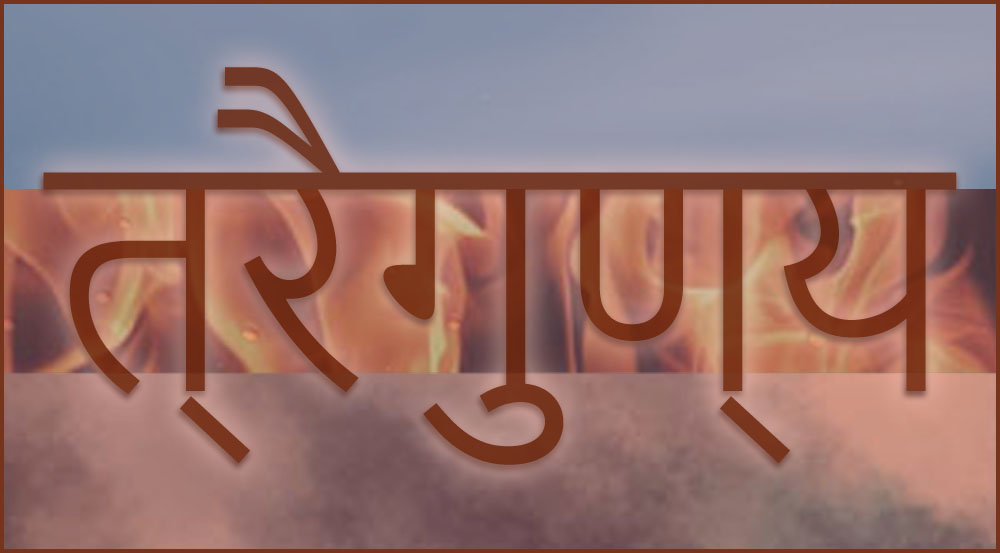The Gunas
The operation of the three Guna qualities is described in Vedic philosophy (including in the Bhagavad Gita), but only in relation to the functioning of the human mind and nature. Selfknowledge.today describes the operation of the Guna’s first in general terms as the primal manifestation of the Law of Three and then delves into what this means for and within our human mind.
Three universal qualities: sattva, rajas, and tamas
In Vedic philosophy, the three causal qualities or attributes to which everything in our universe is subject are described. They are called the three Guna’s (Triguna). They arise from the Nature of the universe. Everything we perceive and study is the play of the three Guna’s, which will continue forever: the Dance of Shiva. They determine the properties and processes in all physical (matter) and all subtle (mind) often called the ‘creation’. By nature, humans are completely subject to the three Guna’s, both physically and mentally (subtle).
In the universe
The three Guna’s are the causal forces behind the emergence and dissolution of the universe, and behind all dynamic processes (arise-exist-decay) in this immense cycle. They are the primal manifestation of the Law of Three. These three attributes of Consciousness belong to the Nature of the Absolute. They are called Sattva, Rajas, and Tamas.
 Sattva, as a universal quality, is completely still; there is no movement in it, and it allows complete Consciousness. It is the origin of existence, flourishing, and life. As a quality, it allows the silent initiating force of Consciousness. It lets all arise and life begin, but itself is not in motion. It causes construction, harmony, ordering, and structure.
Sattva, as a universal quality, is completely still; there is no movement in it, and it allows complete Consciousness. It is the origin of existence, flourishing, and life. As a quality, it allows the silent initiating force of Consciousness. It lets all arise and life begin, but itself is not in motion. It causes construction, harmony, ordering, and structure.
 Rajas (sounding Radjas) is the universal quality behind all movement. Everything that moves in the universe does so through Rajas. It allows the dynamic force of Consciousness in all manifestations, from atomic to astronomical (physical), and mentally, i.e., mentally and emotionally (subtle). It is the quality of action, movement, and transformation.
Rajas (sounding Radjas) is the universal quality behind all movement. Everything that moves in the universe does so through Rajas. It allows the dynamic force of Consciousness in all manifestations, from atomic to astronomical (physical), and mentally, i.e., mentally and emotionally (subtle). It is the quality of action, movement, and transformation.
 Tamas, as a universal quality, is also completely still; there is no movement in it. It allows the dissolving force of Consciousness. Everything dissolves, runs out, dies, and disappears due to Tamas. It is the power that relatively retracts consciousness from manifestations in the universe, in every area. It stops movement. It causes stagnation, decay, lethargy, and death.
Tamas, as a universal quality, is also completely still; there is no movement in it. It allows the dissolving force of Consciousness. Everything dissolves, runs out, dies, and disappears due to Tamas. It is the power that relatively retracts consciousness from manifestations in the universe, in every area. It stops movement. It causes stagnation, decay, lethargy, and death.
In the universe, the Guna’s always determine as a quality, at the micro and macro levels, and make all manifestations and every life possible. They are always all three active in every manifestation, so in each thing, in every process, and at every level, but they are in a varying balance to each other, which differs from moment to moment in place and in time. Ultimately, the entire universe is also subject to the Guna’s. They ‘manage’ the entire process of arising, existing, changing, and dissolving of the universe. It is important to realize that these Guna’s do not stand for energies. They are not forces in the usual sense of the word. But everything that moves and has dynamic energy is through Rajas. This Guna is recognizable in the material and spiritual world as energy. Sattva and Tamas are not, as these are recognizable in every area as the absence of energy. Sattva, as Guna of non-moving still consciousness, and Tamas as Guna that makes energy dissolve.
So much for theory. But an ancient theory like this is only meaningful if it benefits our inner development.
Within Ourselves
If it’s truly the case that everything we perceive is the eternal play of the three Guna’s, then this also unfolds within our individually experienced consciousness. The Guna’s operate both in the physical and the subtle world. They would then also determine the nature of our mind and would always be ‘active’ within us. But what about mental freedom? Based on this ancient philosophy, we can note the following about our mind.
Within our mind, Sattva stands for pure reality and potential, Rajas for activity, and Tamas for decay. In human experience, the Guna’s are recognizable as: attention, passion, and sleep. They’re also known as mindfulness, hyperactivity, and lethargy. Sattva promotes our love for wisdom, Rajas drives identifications and ego-development, and Tamas plunges us into sleep and ignorance.
 With a Sattvic state of mind, we are calm, clear, alert, and creative.
With a Sattvic state of mind, we are calm, clear, alert, and creative.
In a Rajasic state of mind, we feel energy, passion, and mental activity.
With a Tamasic state of mind, we are tired, dull, unclear, and less creative.
Sattva results in, among others: attention, openness, harmony, balance, clarity, peaceful joy, well-being, freedom, equanimity, kindness, compassion, calmness, self-control, contentment, trust, gratitude, fearlessness, and selflessness. Attention is open and free, making external consideration straightforward.
Rajas leads to, among others: activity, passion and desire, identifications, excitement, irritation and anger, audacity, euphoria, restlessness, fickleness, stress, circling thoughts, and being chaotic. Attention is trapped and can instigate internal consideration.
Tamas results in, among others: inactivity, materiality, density, obstruction, laziness, mechanical attachment, rigidity, depression, confusion, addiction, apathy, dissociation, dependency, and ignorance. Attention is obscured, scattered, or numbed, leading to deep waking sleep.
The three Guna’s always work simultaneously in our mind, with one being predominant. The other two bring balance and measure for a ‘healthy’ function of the dominant Guna. This happens through a fully automatic reset of the mutual Guna ratio, keeping us healthy. For example, we can energetically work all day in Rajas, but then we get tired and Tamas dominates, allowing us to sleep. After long silent concentration in Sattva, attention wanes and we feel the urge to move, with Rajas keeping us in good condition. If we become overactive in Rajas, we can fall silent in Sattva, refreshing ourselves with new subtle energy. When we’re sluggish and want to get out of a certain inertia, Rajas can also perk us up by getting us moving. From there, we can more easily enter Sattva than if we tried directly from Tamas. If you’re feeling dull, you can’t suddenly concentrate. It works much better if you first move a bit.
We humans thus have the freedom and ability to influence and adjust the ratio of the Guna’s in our mind. At any moment, we can adjust our inner state to become more balanced. Especially when we’re feeling off, we can consciously balance ourselves by focusing on a balancing Guna.
The Guna’s thus determine the state and quality of our subjective consciousness. We especially notice this when their ratio becomes unbalanced compared to how they’re determined in us individually. We humans have a certain Guna ratio in our nature, in our inherent essence, and it’s dominant in our actions and behaviors. We recognize this by how we are, how we behave, and how we respond to the world around us. By nature, some people are attentive, others are dynamic, and others are passive. They respectively have a preference for mindfulness and attentiveness, exciting activities or opposition, or phlegmatic indifference or slowness/laziness. These are just examples.
We can recognize our own inner nature. Our individualized Guna ratio is fairly fixed. This determined nature can become ‘more transparent’ through self-knowledge, and the Guna’s will then determine our attitude and behavior less mechanically.
.
Summary
- If we have a Tamasic state of mind and thus feel dull, listless, down, or depressed, it helps to move, thereby allowing the effect of Rajas, which reduces the power of Tamas, making us more active and also more observant.
- If we have a Rajasic state of mind and thus feel restless, agitated, irritated, or stressed, it helps to allow the effect of Sattva by physically and mentally becoming still and purely focusing on our Being. This reduces the power of Rajas and we become clearer, more attentive, and especially more awake. If we’re restless in Rajas, by becoming still, through Sattva, we can also allow the effect of Tamas, letting us relax or even sleep.
- In the conscious Sattvic state, we deepen our reflective consciousness, which brings understanding, happiness, and mental purity. We simply feel fulfilled with ‘what is’ and are not plagued by racing thoughts or lethargy. If we are, these thoughts are observed with attention so they no longer control us. It drives spirituality and strengthens our Magnetic Center. A Sattvic state of mind yields subtle energy and self-knowledge.
When Sattva dominates in our mind, our highest discerning ability (Buddhi) works optimally. We then perceive much goodness and even divinity in all beings and objects around us, and interact with situations in loving peace and kindness. A Sattvic mind is stable, easily enters Self-remembrance, and connects with our true nature: Sat-Chit-Ananda (consciousness – knowledge – joy-experiencing). A Sattvic mind brings clarity to our head, purity to our heart, and facilitates adept hand-ling.
During the course of the day, we can easily recognize the Guna’s by their tangible presence. From the night, where Tamas and unconsciousness dominate, we transition to the dawn – the blue hour – with a Sattvic and consciously felt stillness that feels very different from the denser stillness of the night. This dawn awakens everything, bringing it back into consciousness in an almost magical and open stillness. From there, more and more life begins to move. The animal kingdom naturally follows this rhythm, with the first birds starting to chirp. Rajas increasingly dominates, and by full daylight, everything becomes dynamic with growing noise and sound. This Rajas-driven activity continues throughout the day. Then, in the afternoon, there’s often a dip: Tamas typically asserts itself around four o’clock, especially for those sensitive to it. Work might feel a bit heavier at this time. By late afternoon or early evening (this varies with the seasons), Rajas begins to wane, allowing Sattva to dominate again. Birds quiet down, the wind often subsides, and one notices a distinct change in the atmosphere. A sort of energetic purity emerges. An open stillness can be felt. Gradually, Tamas takes over, leading us into the night where all activity and consciousness are minimized: a stillness dominated by unconsciousness.
Furthermore, different Guna balances can be clearly recognized in various weather conditions, as well as in the four seasons as a whole.
